1lumen selects and reviews products personally. We may earn affiliate commissions through our links, which help support our testing.
Astrolux ST01 review
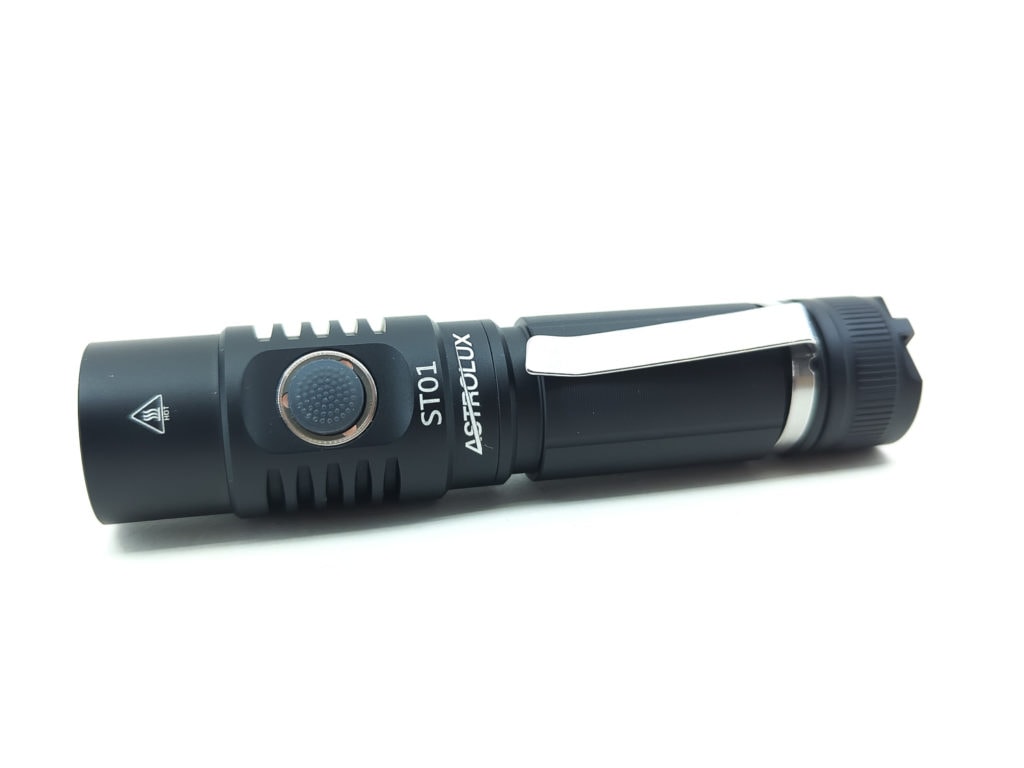
Astrolux ST01 specifications
| Brand/model | Astrolux ST01 |
|---|---|
| LED | CREE XHP50.2 |
| Max. Lumens | 3,500 lm |
| Max. Beam intensity / distance | 25,281 cd |
| Battery config. | 1*21700 |
| Onboard charging | USB-C |
| Modes | 4 |
| Blinkies | Strobe, SOS |
| Reflector | Smooth |
| Waterproof | IPX6 |
| Review date | May 2022 |
Introduction:
Astrolux – the “house brand” of the popular retailer Banggood. While Banggood never discloses the OEM behind the Astrolux flashlights, they are commonly produced by Mateminco and Sofirn. I can’t really say who made the new Astrolux ST01. But it is an intriguing value-centric offering of a high-brightness, 21700-powered tube-light. To me, this arrangement seems to be an “around the house” or “walk the dog” sort of light. It’s perhaps a bit large for EDC purposes, and it definitely isn’t tactical.
Package quality.
Astrolux rarely (ever?) splurges on fancy packaging. As expected, the ST01 arrived in a plain brown cardboard box with the Astrolux logo. Inside, the light was nestled into custom-cut white foam along with its modest offering of accessories. In all, the box contained:
- Astrolux ST01
- Spare o-rings
- Lanyard
- Manual
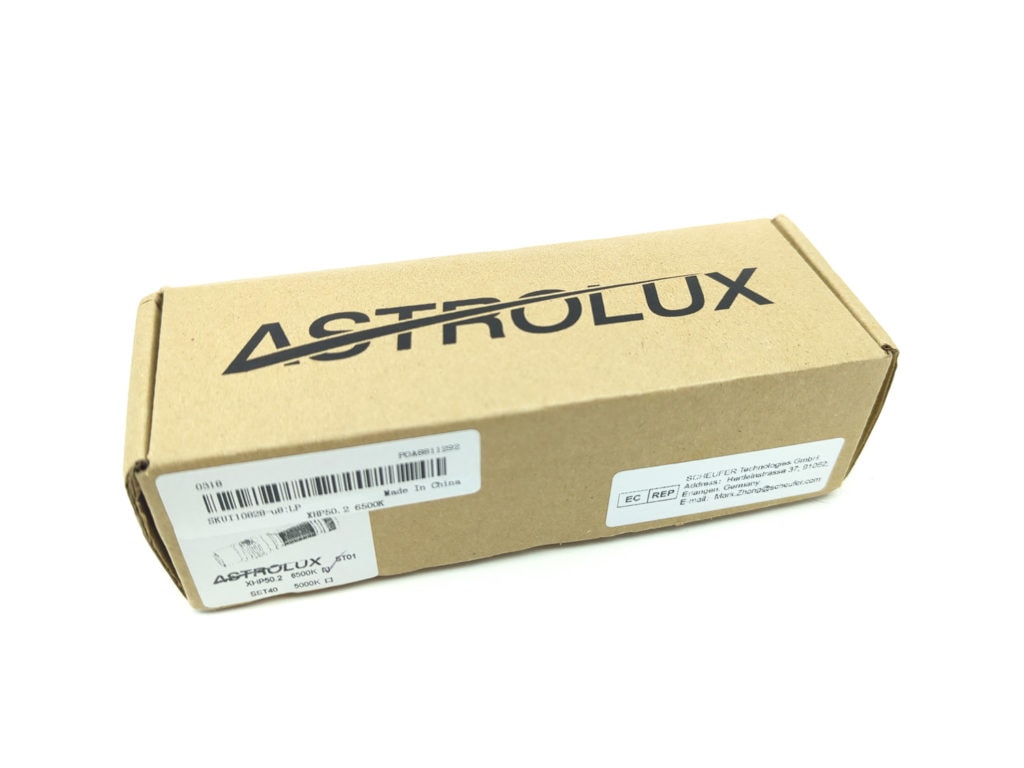
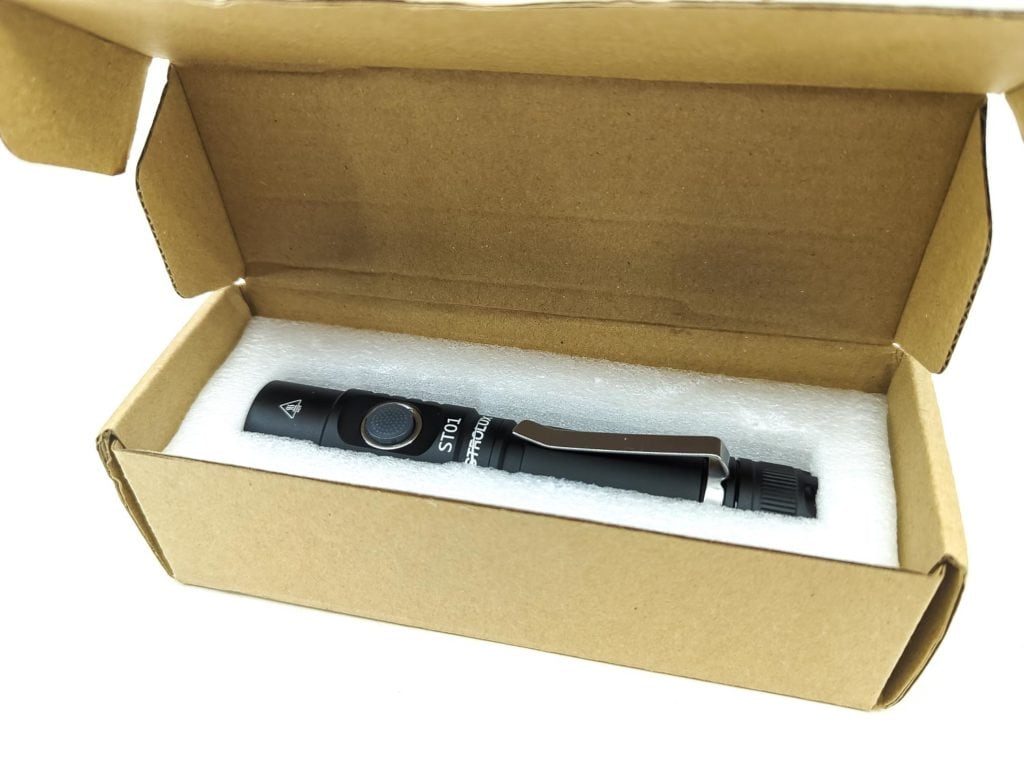
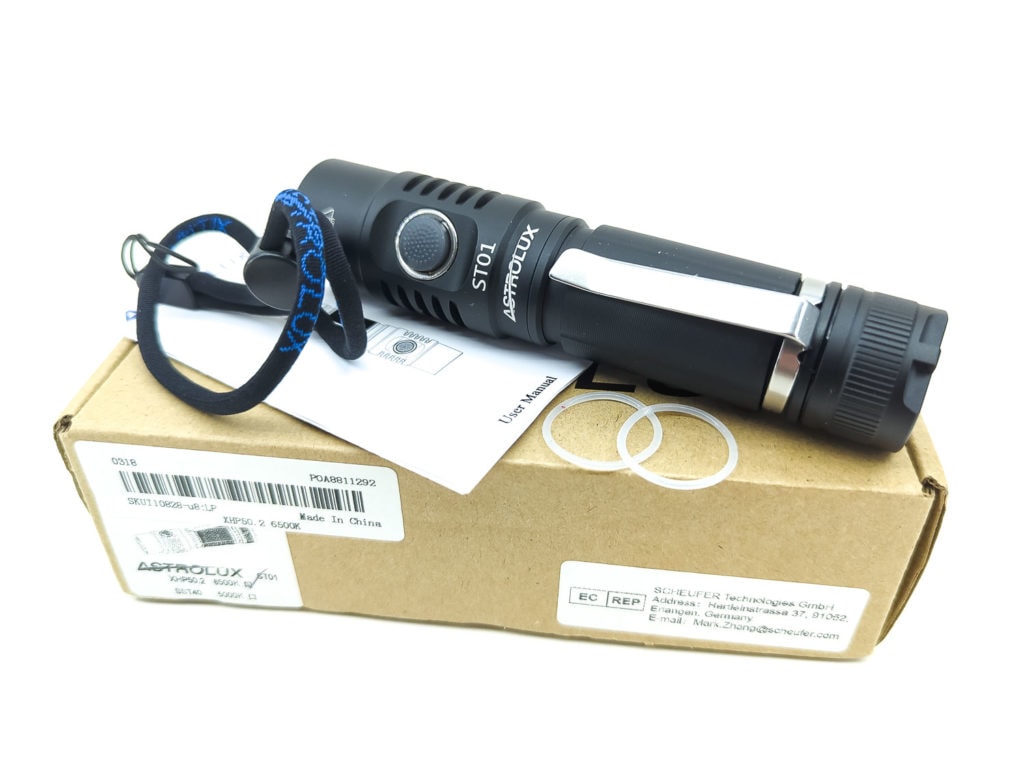
Flashlight in use
The Astrolux ST01 feels about like your average 21700 tube light does: moderately sized and easy to hold. While the body is quite smooth, the heatsink fins have some grip to them in case you lose your grip and end up grasping for the light.
There is one switch: an e-switch that sits in a recessed area on the head of the flashlight. The button cover is smoke colored and houses indicating LEDs. Opposite of the button is the USB-C charging port and its rubber cover.
The ST01’s tailcap is perfectly flat and allows for easy tail standing. The tail has an exposed lanyard attachment point. The hole for this is a bit on the small side; you’ll likely need a pin or SIM tool or the like to put the lanyard through the hole. The lanyard itself is actually nicer than expected. It has an adjustment bead and is branded Astrolux in blue lettering.
As mentioned in the intro, I feel like this is a pretty good “going for a walk” or an “around the house” kind of light. In my opinion, it is too big for EDC purposes. Its beam is good for mid-range distance.
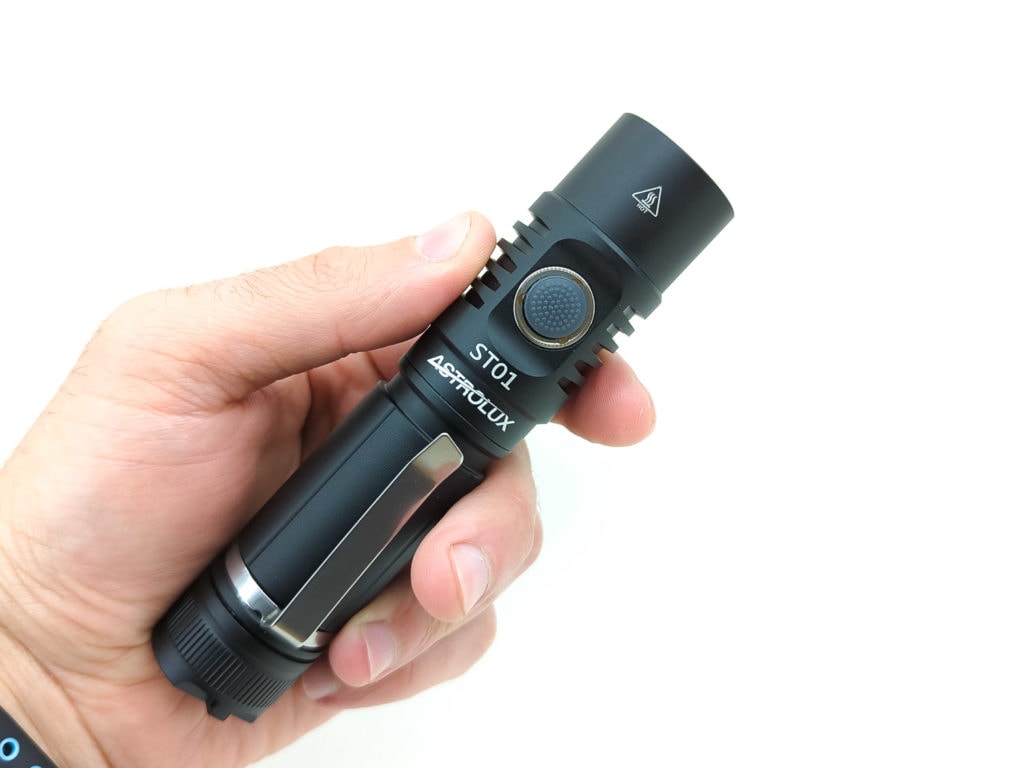
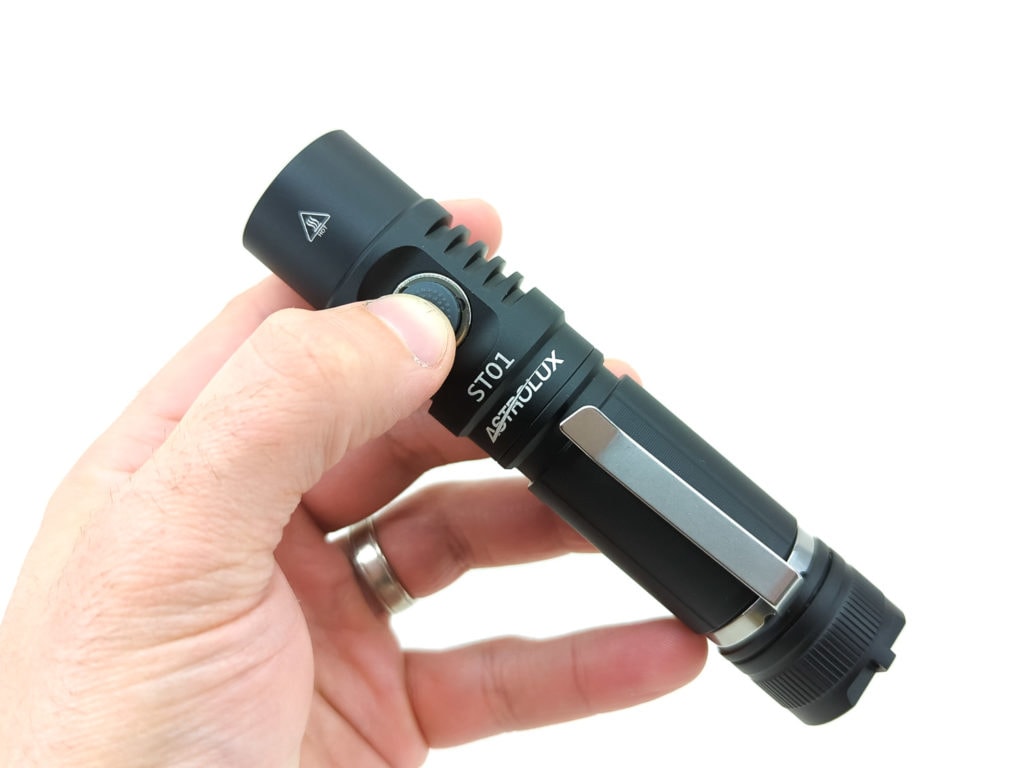
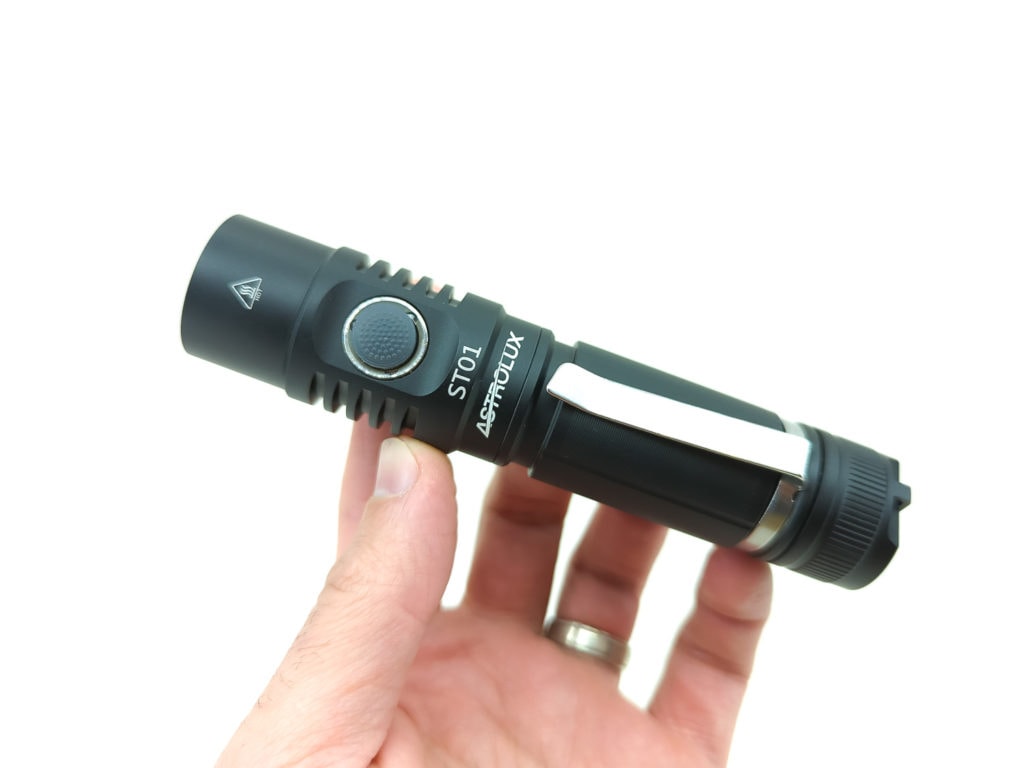
Build Quality, and Warranty
My initial impression of build quality was surprisingly good. The “HA III” anodizing on the aluminum is smooth and matte without being chalky. The tail threads are pretty good. There are dual springs in the tailcap, albeit a bit large/long. Overall the machining seems really nice. But then a few issues started to creep up. I accidentally dropped the tailcap by itself on the floor and the anodizing easily got nicked. With it getting dinged so easily, it makes me question the HA III claim. And that lanyard attachment point… Rough. Like “rip a hole in your pocket” kinda sharp. Most other surfaces are nicely chamfered, but it seems like they missed that vital edge.
According to the manual, the warranty terms are:
- Unconditional return in 15 days on product problems
- 12 months warranty
- Lifelong paid warranty
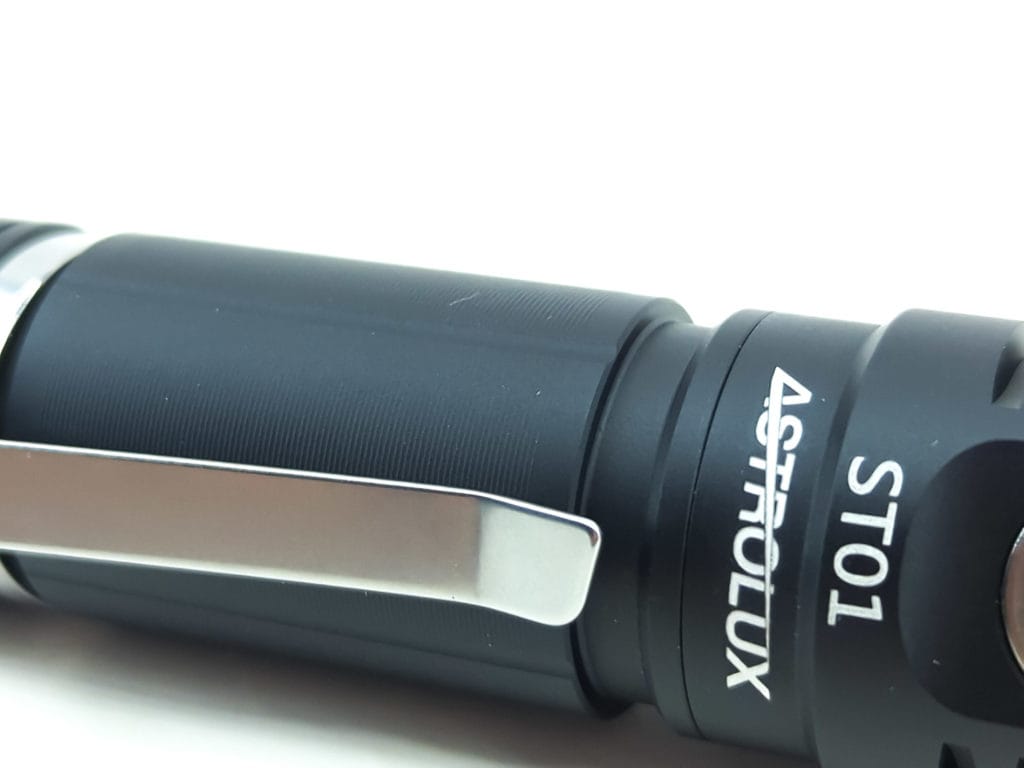
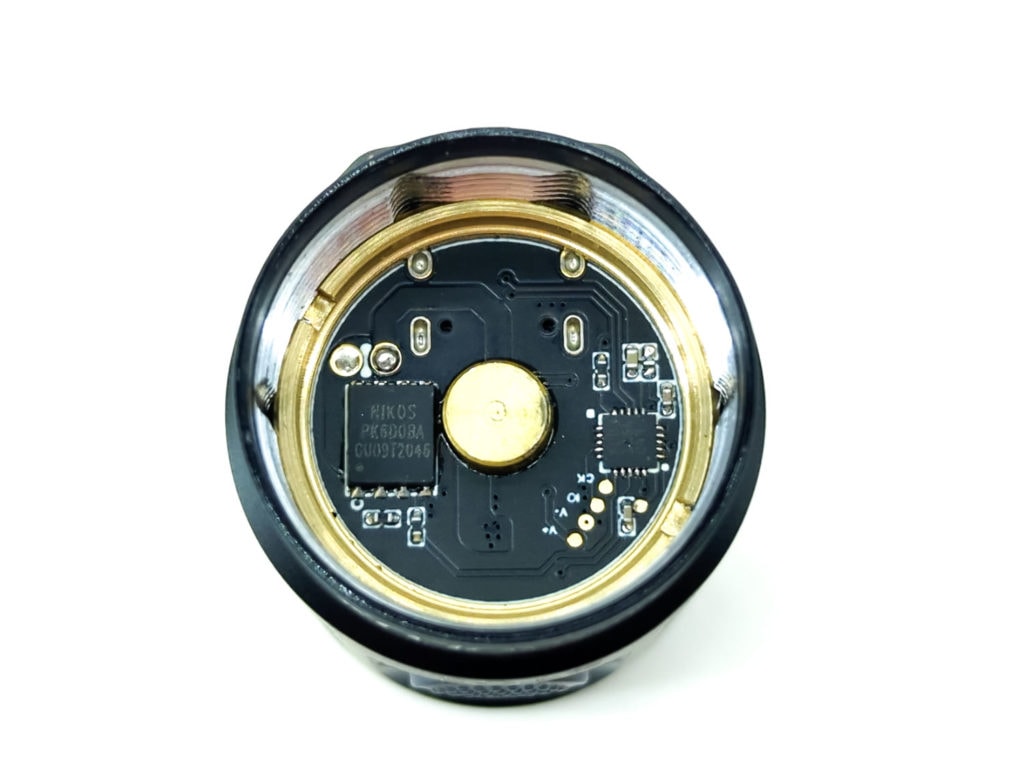
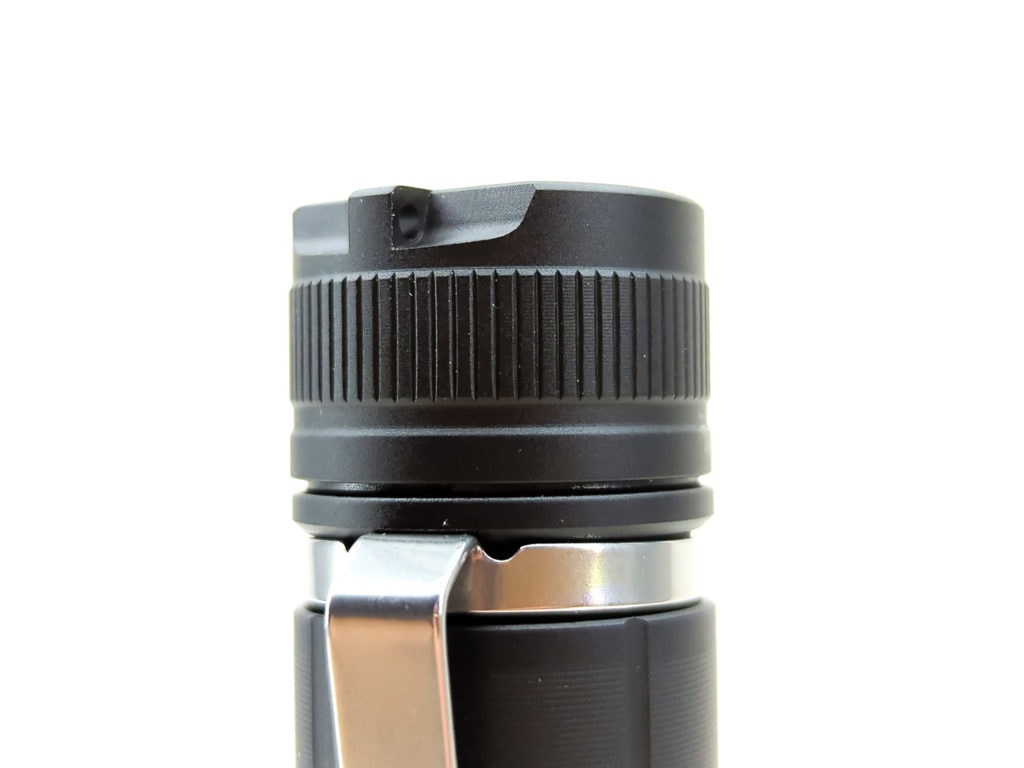
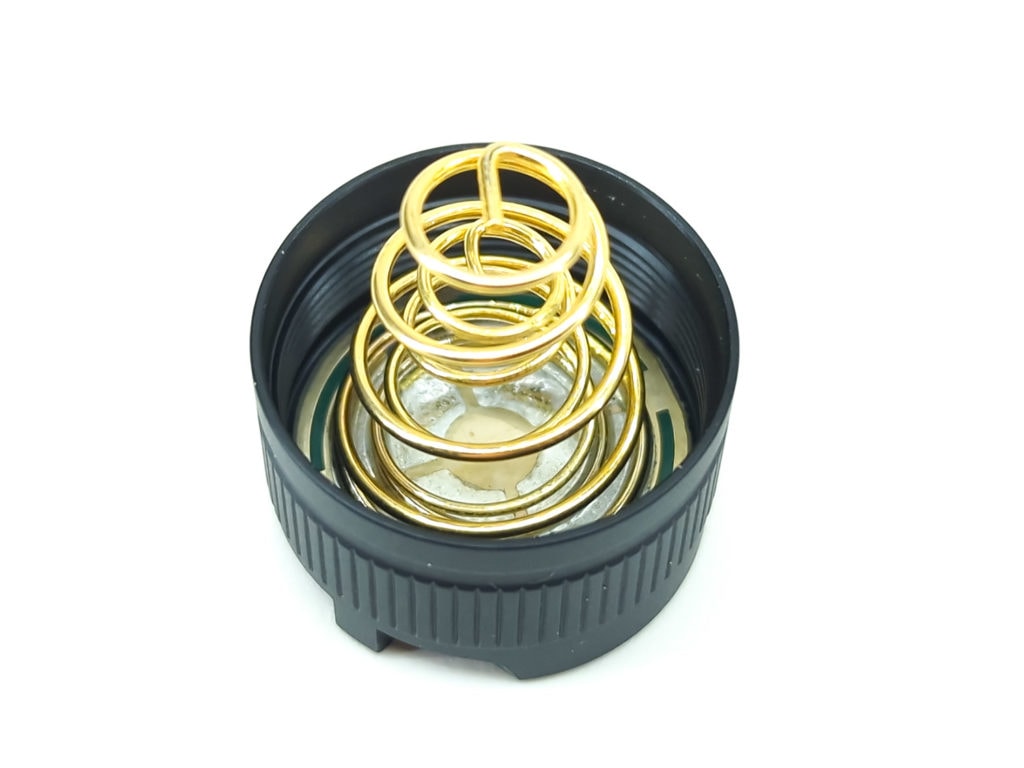
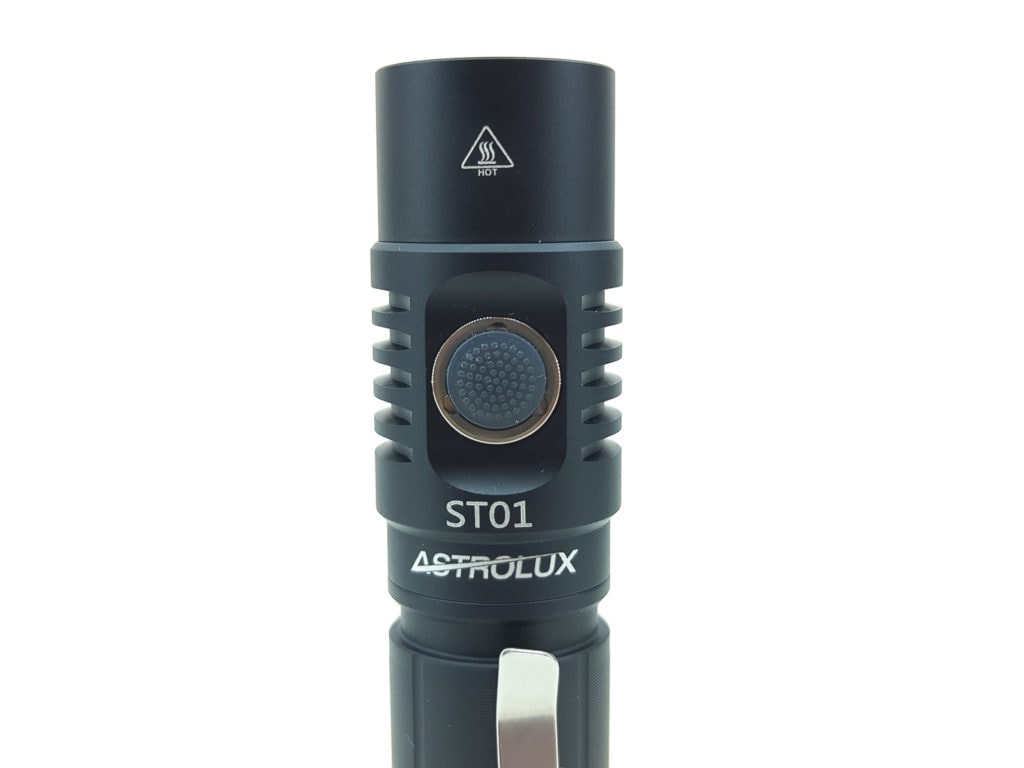

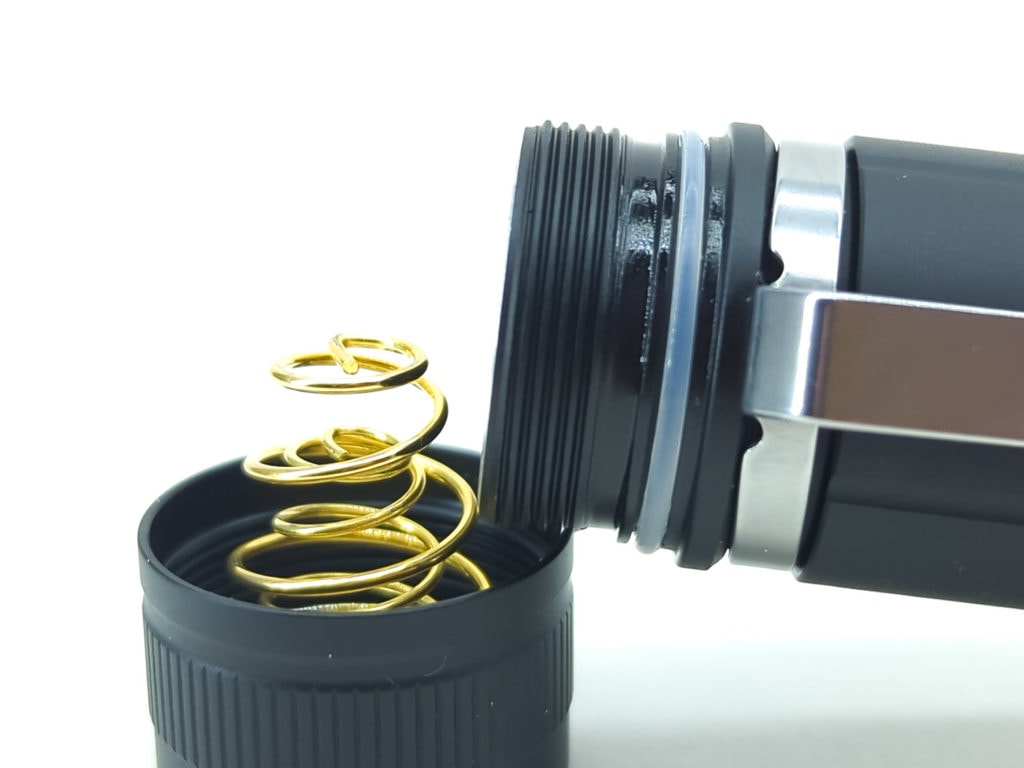
LED, Lens, Bezel, Beam, and Reflector
Astrolux provides two LED choices with the ST01: a 6500K Cree XHP50.2 or a 5000K Luminus SST40. The Luminus LED will be warmer (in terms of CCT), but not as bright or power hungry. My sample has the Cree XHP50.2.
The LED is nicely centered in a fairly deep smooth reflector. The reflector is surrounded by a smooth aluminum bezel that feels like it is probably glued in place – I couldn’t remove it by hand at least.
Between the flip-chip Cree LED and the smooth reflector, the XHP50.2 option isn’t a light that you’ll want to take on your next white-wall hunting adventure. The beam has the expected “Cree rainbow” even throughout the hotspot. The Luminus version, while I don’t have it available for testing, likely isn’t quite so bad.
The Opple Light Master gave these readings:
- CCT: 7456K
- CRI: 73.2
- DUV: -0.0042
While I was expecting a cool white beam, it is even cooler than expected. The readings (CCT, DUV) were extremely dependent on where in the beam I measured. The unevenness of the beam caused large swings in the readings.
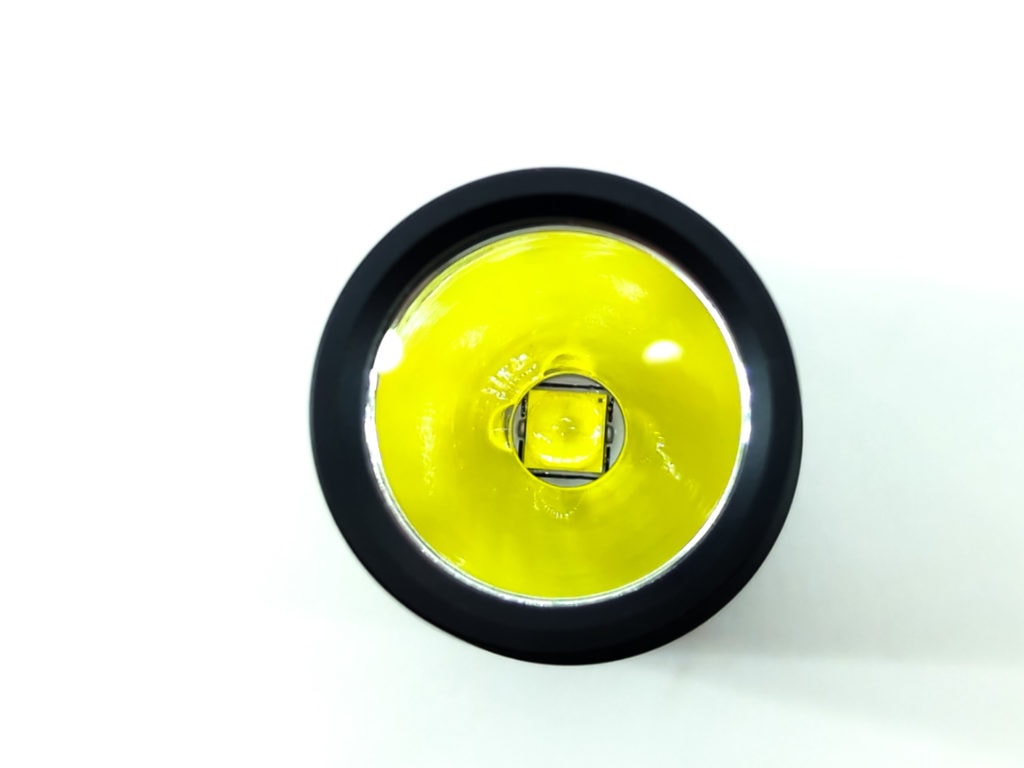
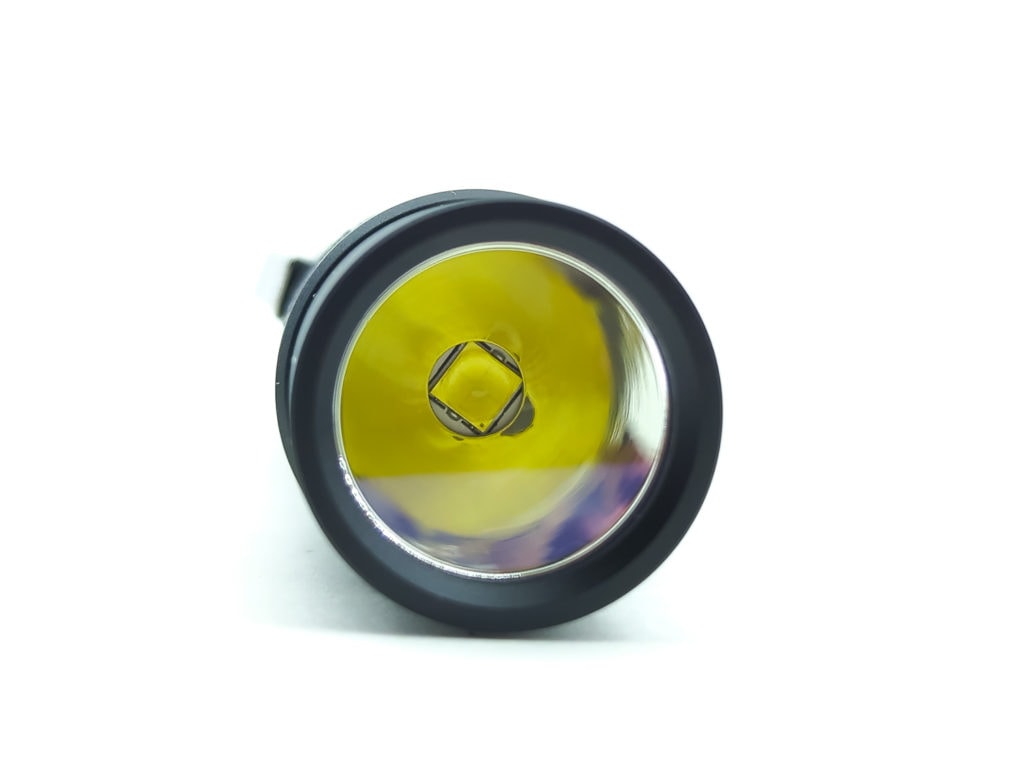
Dimensions and size comparison
- Length: 130 mm / 5.1 inches
- Head diameter: 27.5 mm / 1.1 inches
- Body diameter: 27 mm / 1.1 inches
Weight:
- Without cells: 103 grams / 3.6 oz.
- With cells (Samsung 50G): 172 grams / 6.1 oz.
21700 flashlights comparison
Mid-size 21700 tube lights, left to right: Sofirn SP35, Astrolux ST01
Various 21700 flashlights, left to right: Amutorch S3, Astrolux EC01, Astrolux ST01, Nitecore P20iX
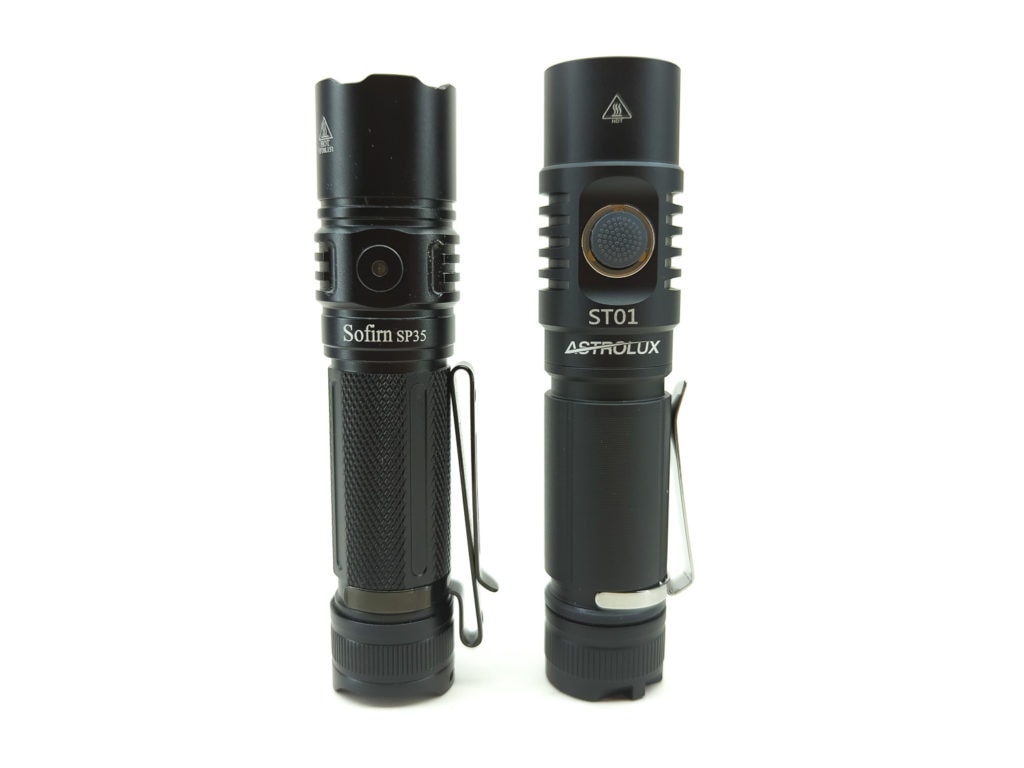
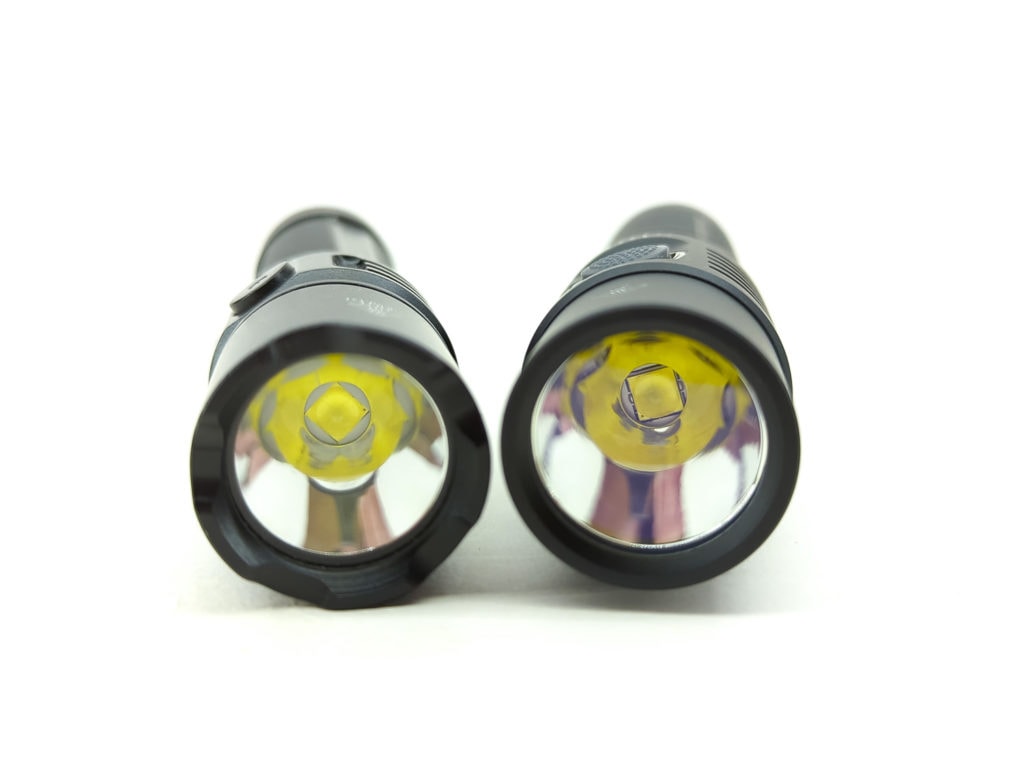
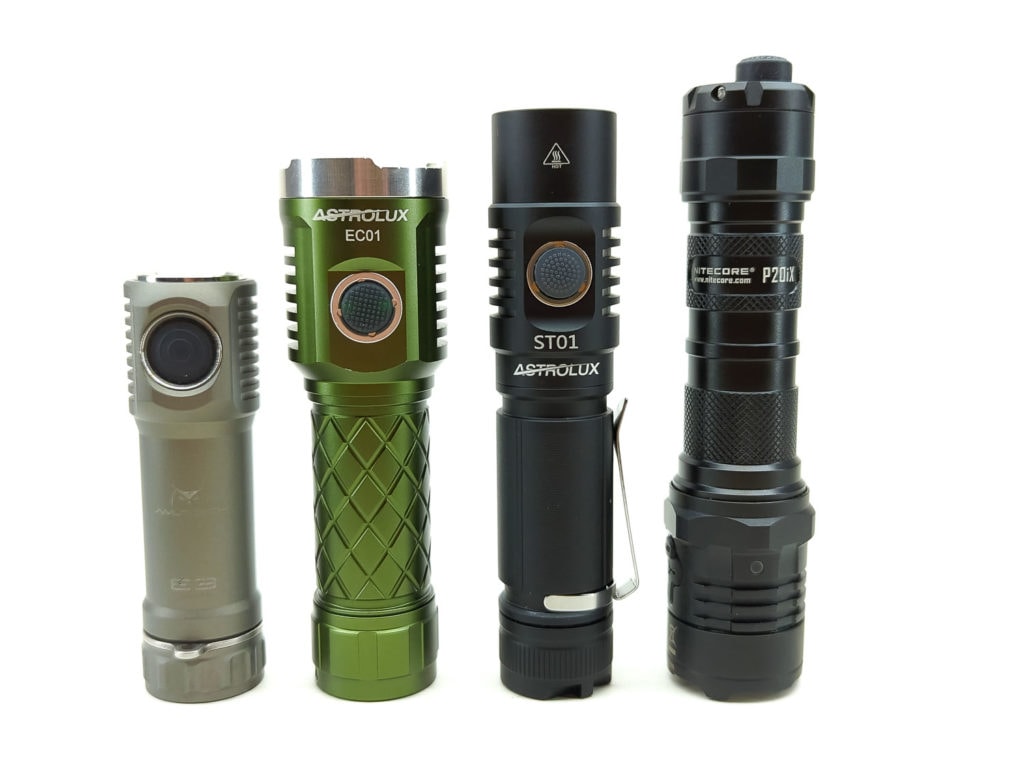
Driver & User Interface:
Astrolux describes the driver as being a “high efficiency direct drive driver”. If all you care about is full-throttle Turbo, then yes, I suppose direct drive is highly efficient. But I would argue that solely direct-drive isn’t very efficient for lower modes, and certainly isn’t very stable as output will vary with the battery voltage.
Available modes: Low, Mid, High,Turbo
From OFF:
- Single click: turn on (memorized mode)
- Double click: Strobe
- 3 clicks: Mode Group change
- 4 clicks: Voltage Check
- 5 clicks: Lock / Unlock
- 6 clicks: Momentary Mode
From ON:
- Press and Hold: turn off
- 1 click: change mode
- Double click: Turbo
- 3 clicks: Mode Group change
- 5 clicks: Lock
Mode memory:
- Yes, there is mode memory for non-strobe modes
Shortcuts:
- To Low: none
- To Turbo: double click while On
- To Strobe: double click while Off
Low voltage warning:
- Green LED in button flashes as a warning
Strobe/blinkies
- Strobe: double click from Off
- In Mode Group 2, Strobe and SOS are in the normal mode rotation
Lock-out mode:
- 5 clicks to Lock and Unlocked
PWM
- PWM is not visible. My photodiode + DMM says that there is 48 kHz PWM, but that’s too fast to readily pick up by the human eye.
Additional info on the UI:
- There are two different mode groups. Mode Group 1 contains the “regular” modes only: Low, Mid, High, and Turbo. Mode Group 2 drops Mid mode and adds Strobe and SOS to make the rotation: Low, High, Turbo, Strobe, and SOS.
- I had the opportunity to select the Astrolux ST01 as a prize light in the 2021 BudgetLightForum’s annual Old Lumens contest. I passed on this light. Why? The UI. I knew just by reading through it that the UI would drive me nuts. I was right; I can’t stand this UI.
Batteries & Charging
The Astrolux ST01 uses 21700 batteries. It doesn’t come with one. For my testing, I used a Samsung 50G battery which is a flat-top cell. The positive contact is a brass button.
The tailcap has large double springs which allow for varying lengths of cells.
The ST01 has USB-C via a port on the side of the head under a rubber flap. I observed charging around 1.6 amps (8 watts) which is a little slow for large 21700 batteries. Unfortunately, the charge rate slowed down very quickly on my sample. After 16 hours, the ST01’s indicator LED was still red (which means charging) and my USB meter showed that only 2098 mAh had been transferred which is less than half of the battery’s capacity and charging was just a trickle at 0.1 watt. I called it quits and finished the charge cycle on a stand-alone charger. I tried charging again with several different chargers (both USB-A and USB-C) and cables and all of them acted in this way. We reached out to Banggood regarding this issue and they assured us that this is the first report of such a problem. So take this as you will. Make sure to keep an eye on the charging of your ST01 and contact Banggood if you have any such problems.
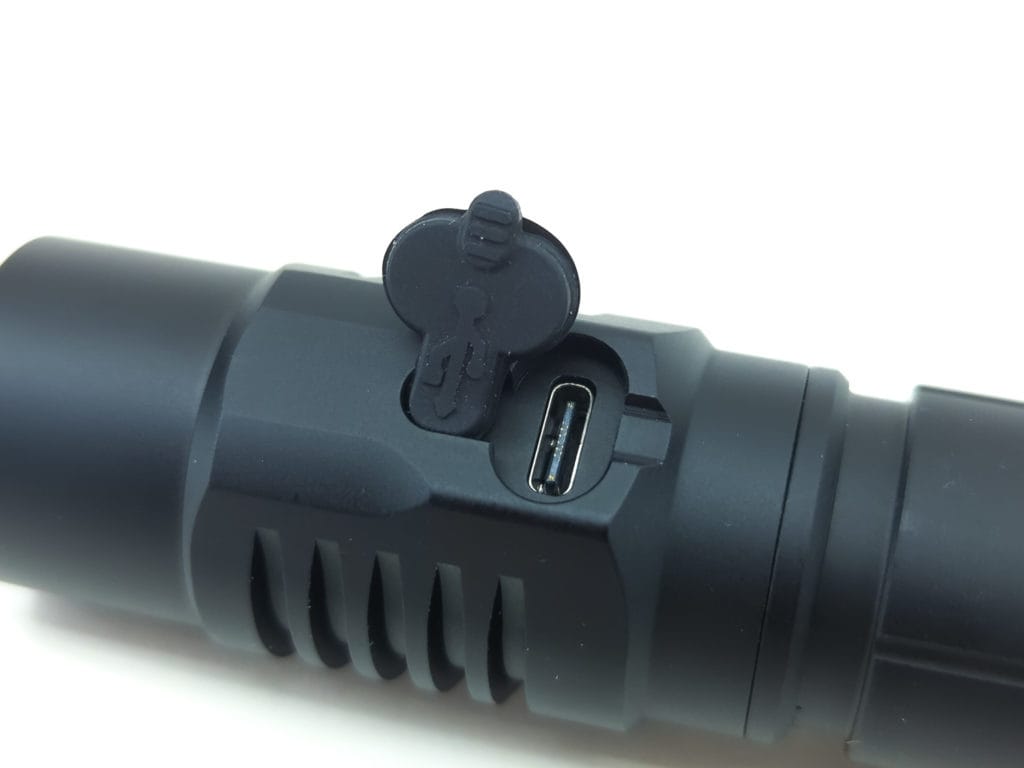
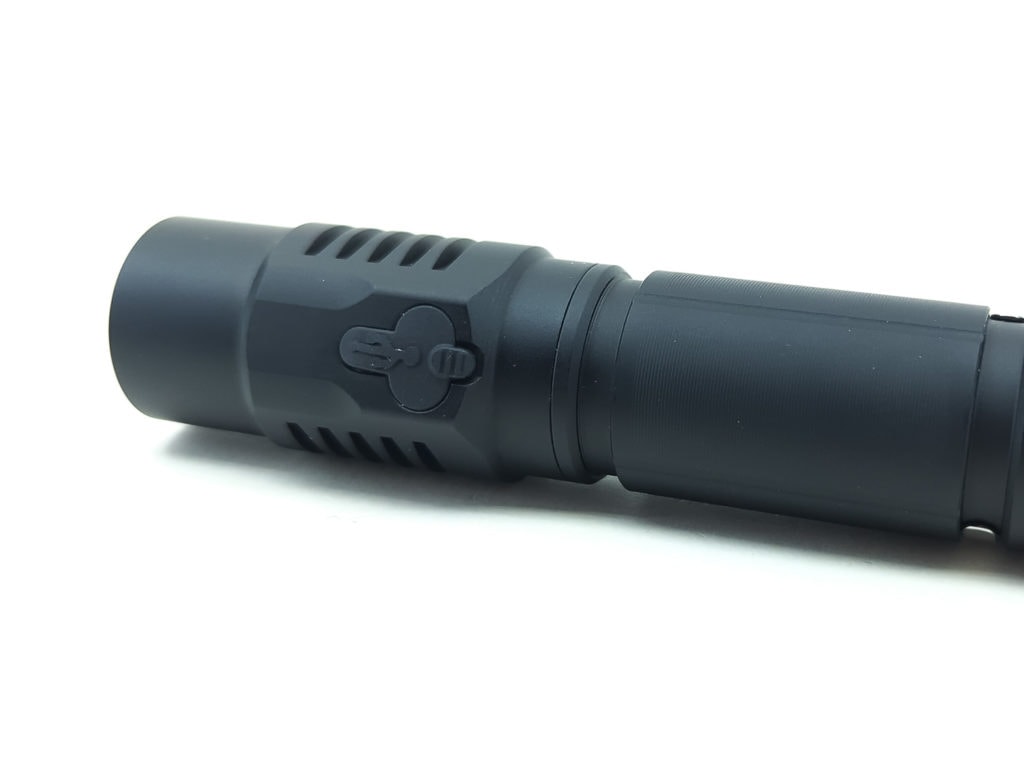
Performance test
Lux was measured by a UNI-T UT383 BT at 5 meters. Lumens were measured in a homemade lumen tube using a TSL2591 sensor, calibrated with a Maukka calibration light. The temperature was monitored with a MLX90614 IR temperature sensor. A Samsung 50G battery was used.
Lumen measurements (for each mode)
| Mode | Amps at start | Specs | turn on | 30 sec | 10 minutes |
|---|---|---|---|---|---|
| Low | 0.16 A | 20 lm | 96 | 96 | – |
| Mid | 2.0 A | 450 lm | 957 | 928 | 846 |
| High (cooled) | 6.3 A | 1200 lm | 2473 | 2231 | 1438 |
| Turbo (cooled) | 14.8 A | 3500 lm | 4775 | 3995 lm | 878 |
Parasitic drain:
- 4 µA
Runtime graph

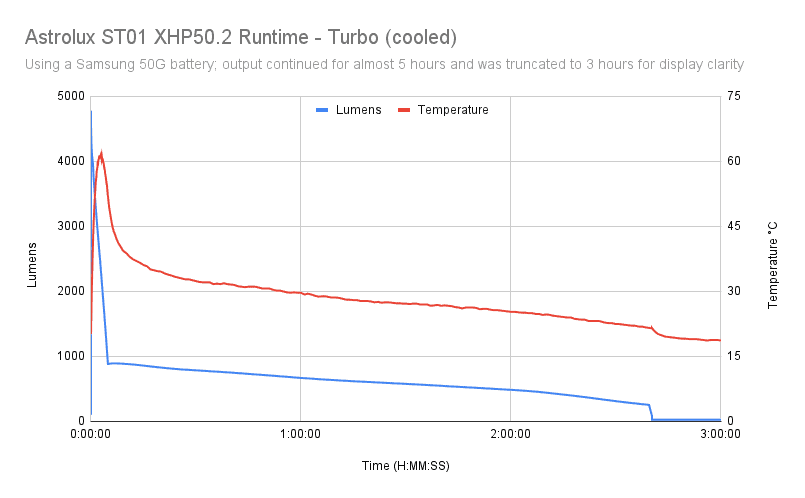
The Astrolux ST01 claims it has temperature regulation, so I started a Turbo test without any cooling. By 2 minutes into the test the temperature was a searing 83°C so I quickly stopped the test and used a towel to carefully open the light and remove the battery.
I restarted the Turbo test, this time with a small fan blowing on it. It started out at 4775 lumens and output dropped a bit as the battery voltage sagged under the large power draw. At 36 seconds the output was 3967 lumens and I could tell that a ramp-down had begun; the temperature was 41°C. At 4m52s, the ramp-down stopped with the lumens at 878. From there, the output adjustments stopped and output slowly dropped as the battery drained down. At 2h39m, a low voltage drop occurred, taking output down to 21 lumens. It stayed there for another 2 hours, finally shutting off at 4h46m. The maximum temperature was 61°C.
After the extreme temperatures seen in the non-cooled Turbo test, I cautiously started a High non-cooled test. It started out ok, but by 22 minutes the temperature had reached a toasty 75°C which is too hot for my comfort level and I quit the test.
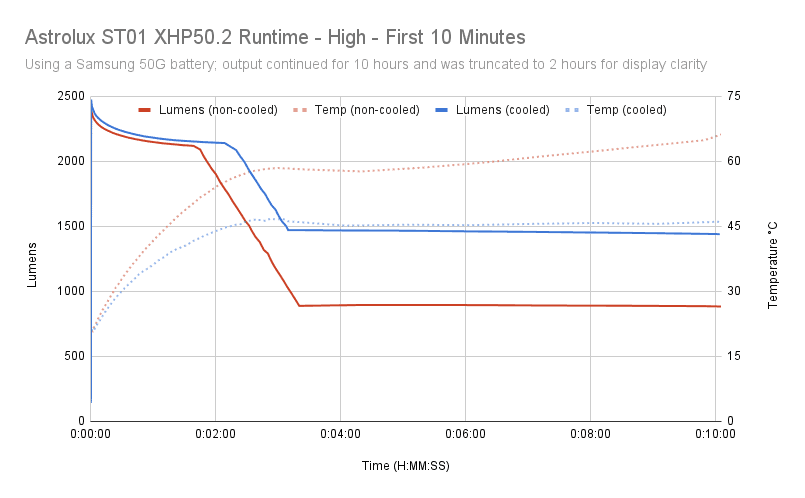

So I started a High test with a small fan for cooling. Output began at 2473 lumens. At 2m8s the output was at 2138 lumens and temperature was 45°C. At that point, the output began to ramp down. The ST01 stopped ramping at 3m9s with output at 1469 lumens. The output gradually dropped as the battery dwindled down. A low voltage drop occurred at 1h38m, going from 430 lumens to 23 lumens. Output kept slowly going down over the next 8+ hours. The light finally shut off at 10h2m with a max temperature of 47°C.

The Mid level run went ok without the cooling fan, but it still hit 71°C which is hotter than I’d like to see. Output began at 957 lumens. There wasn’t much of an intentional ramp-down at any point except at 2h51m when a low voltage step-down took output from 238 lumens to 21. The light petered along before finally shutting off at 9h5m.
Due to the extreme temperatures I observed, I thought that the “active temperature control function” was marketing BS. But then I overlaid the output graphs of the non-cooled vs cooled runtimes and it’s evident that there is some sort of temperature control function, but I’d say it’s not smart enough to safely regulate the temperature on its own. In the High test, I can see that the output dropped sooner and farther in the non-cooled test than it did in the fan-cooled test.
Throw numbers:
Throw was measured at 5 meters after 30 seconds
| Mode | Specs | Candela measured | Meters | Yards |
|---|---|---|---|---|
| Turbo | 25,281 cd | 20,775 cd | 288 m | 315 yd |
Beamshots
Beam shots of the building are taken at 15 m (16 yd) using a Pixel 6 set to ISO 200 with 1/10 second exposure time.
Beam shots of the playset are taken at 30 m (33 yd) using a Pixel 6 set to ISO 200 with 1/2 second exposure time. The trees in the background are around 65 m away.
- Astrolux ST01
- Sofirn IF25A
- Astrolux MF01 Mini
- Olight Warrior Mini 2 Cu
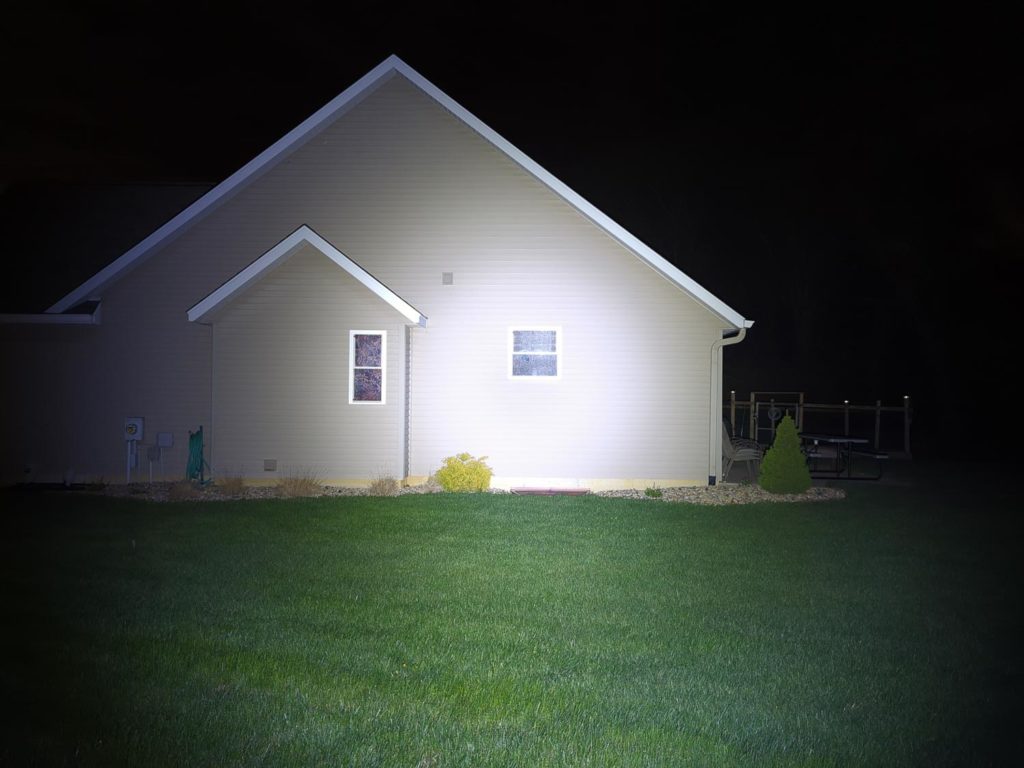
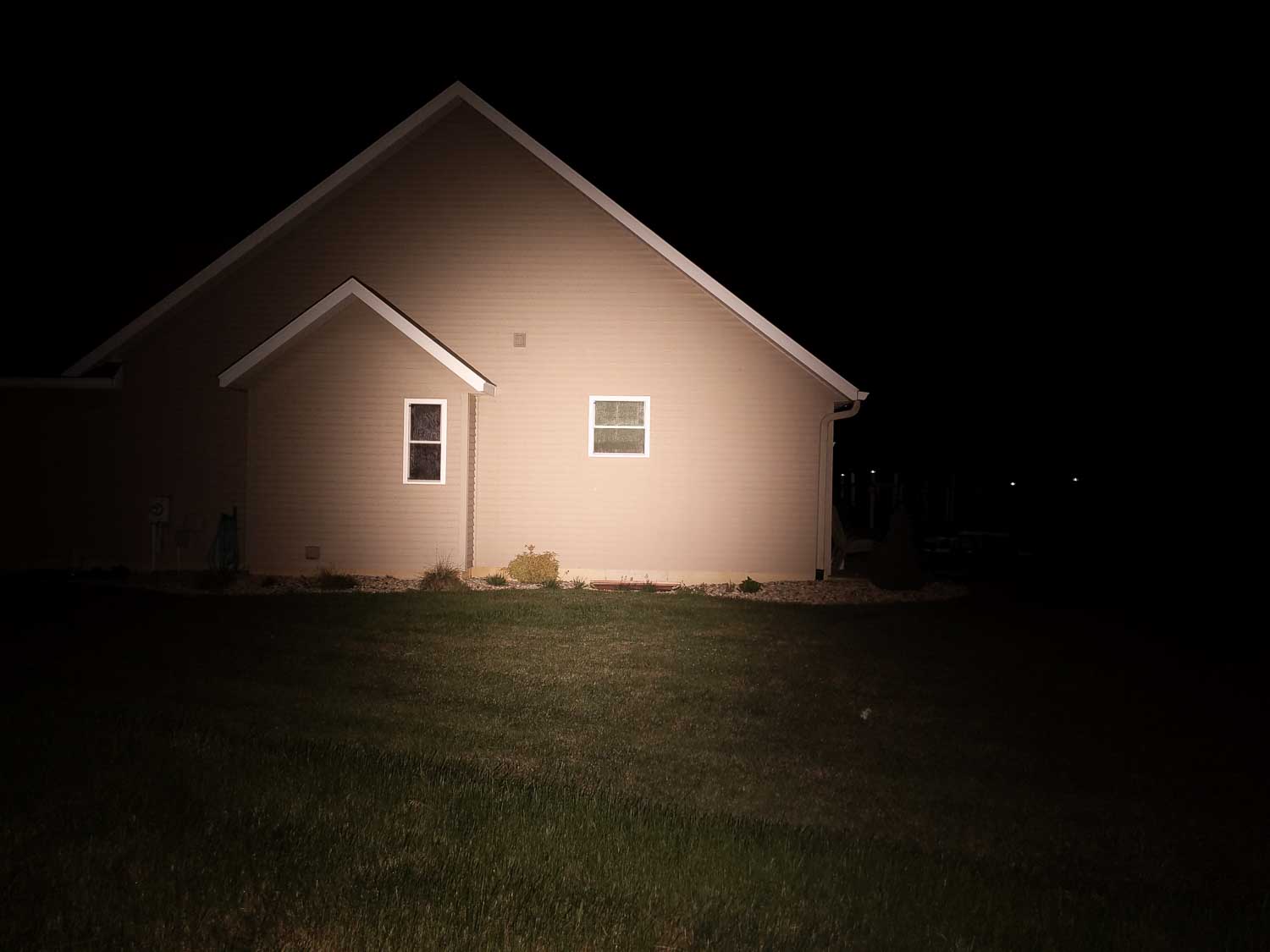
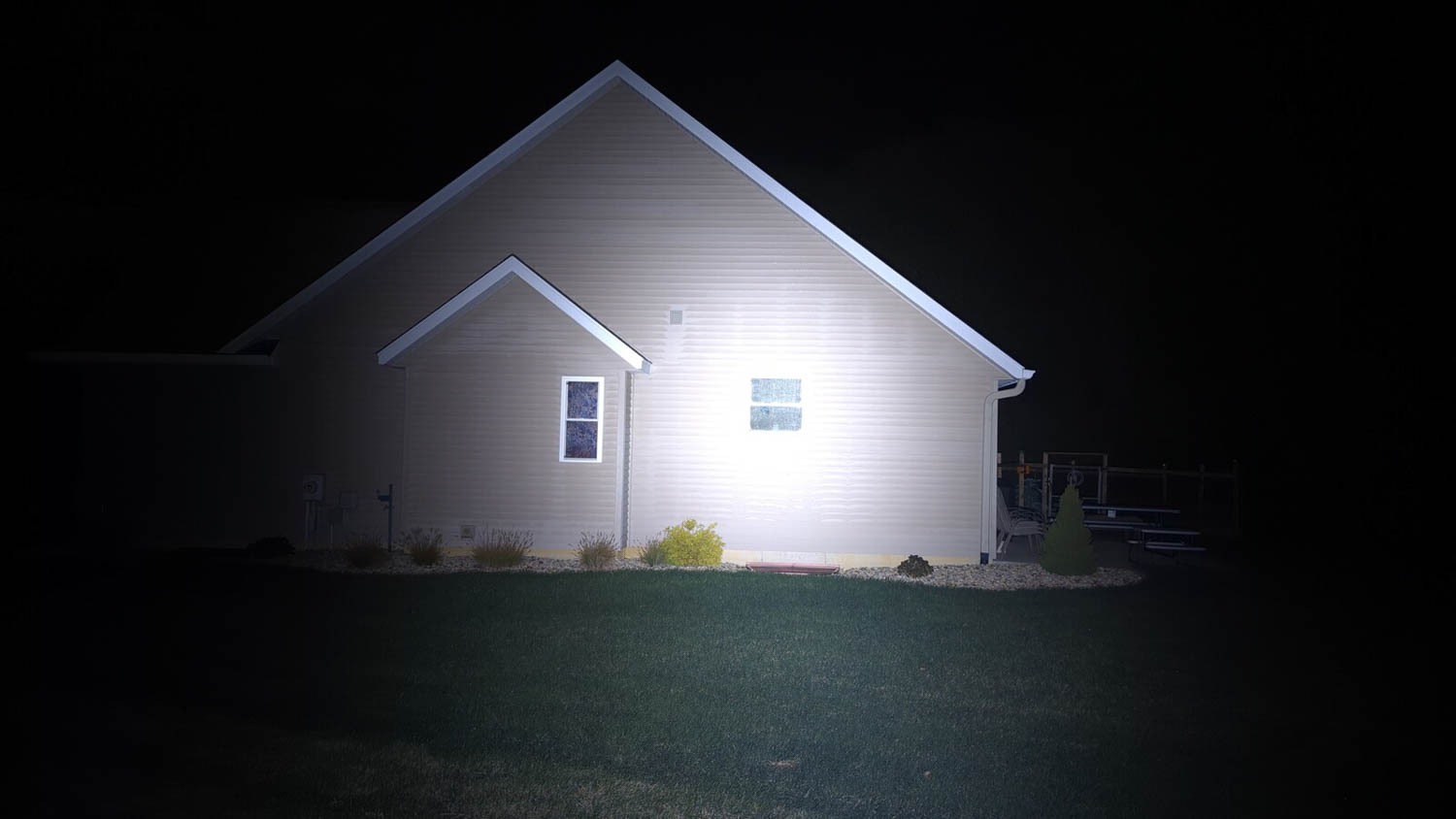
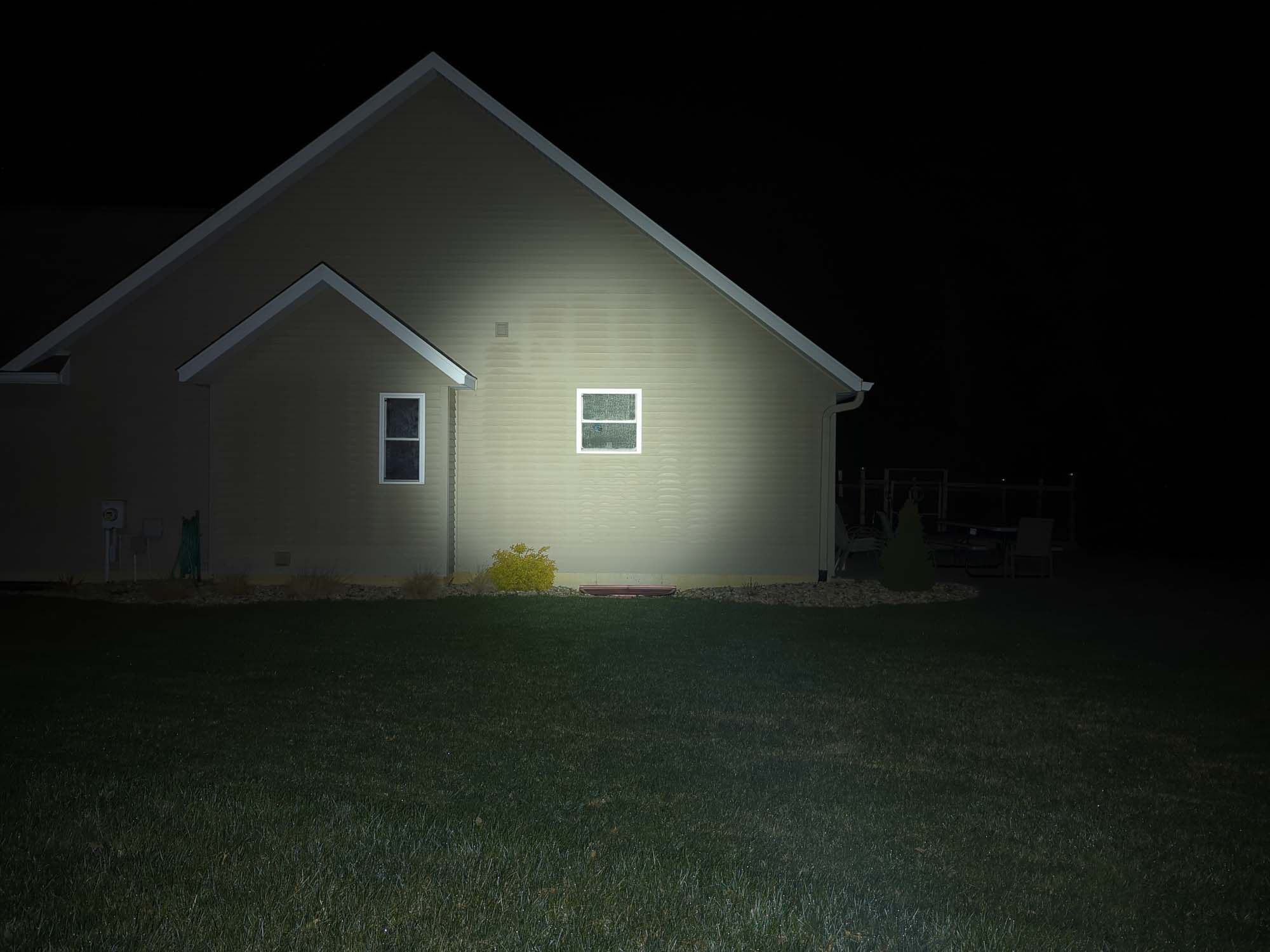
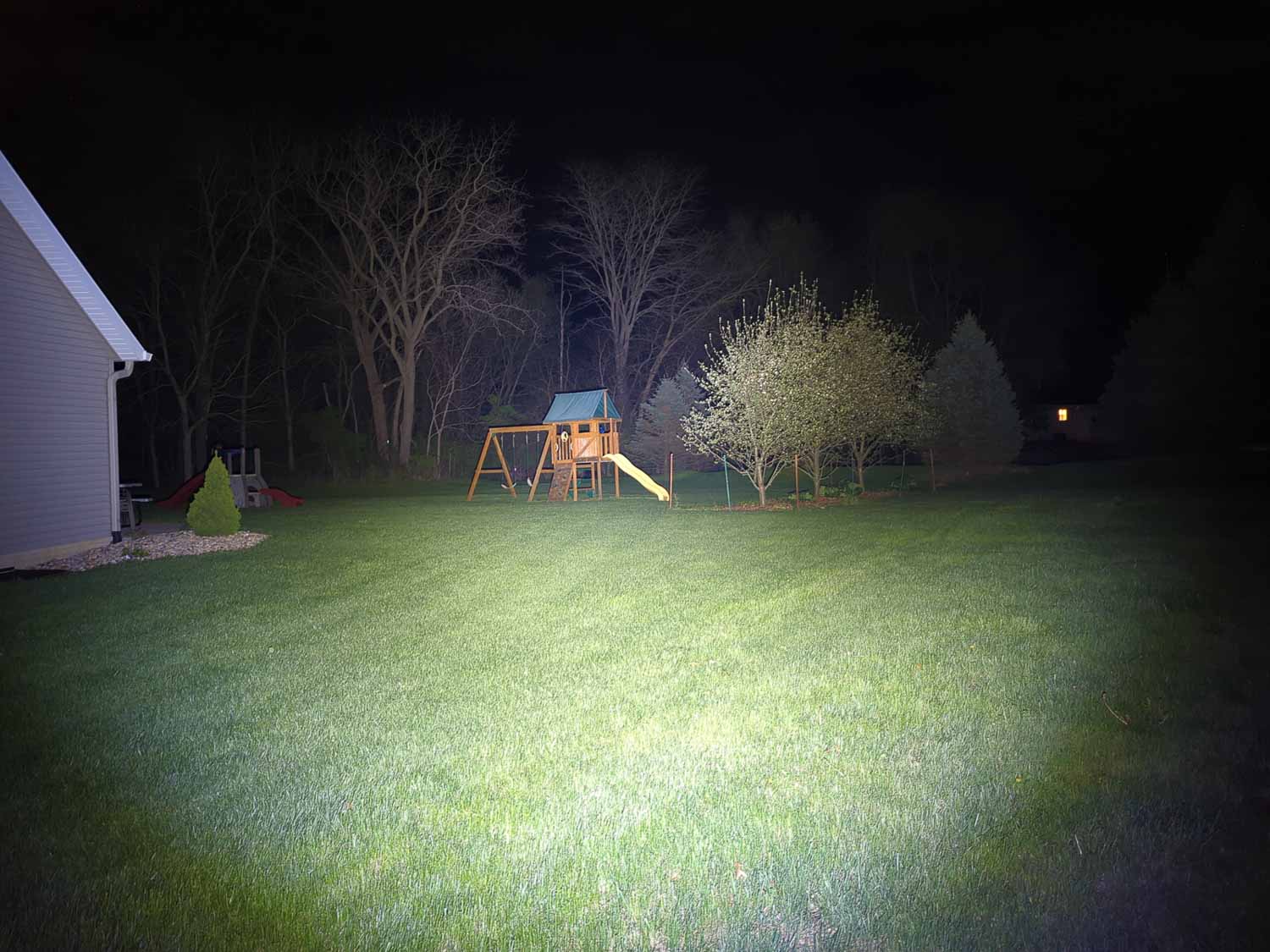
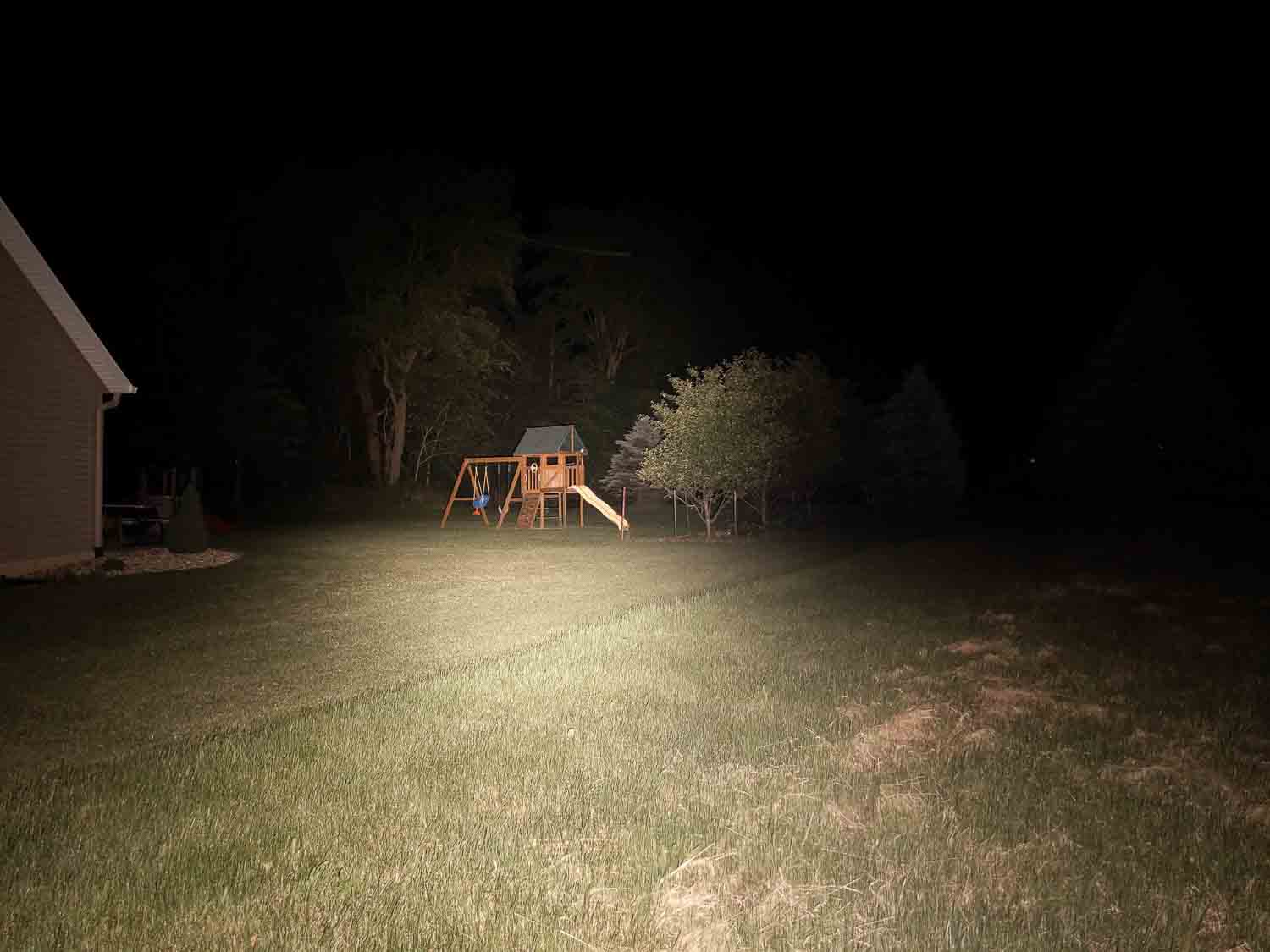
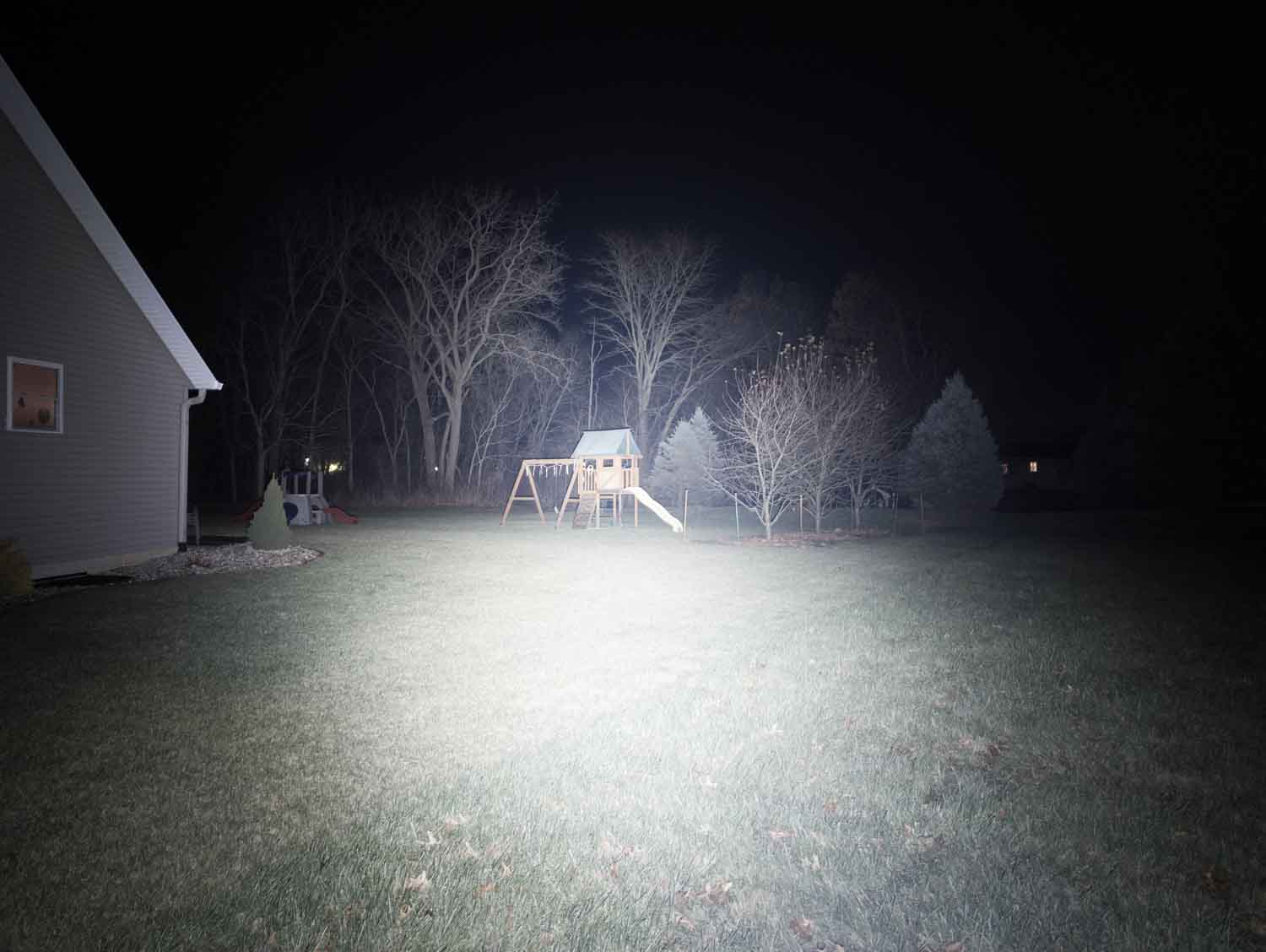
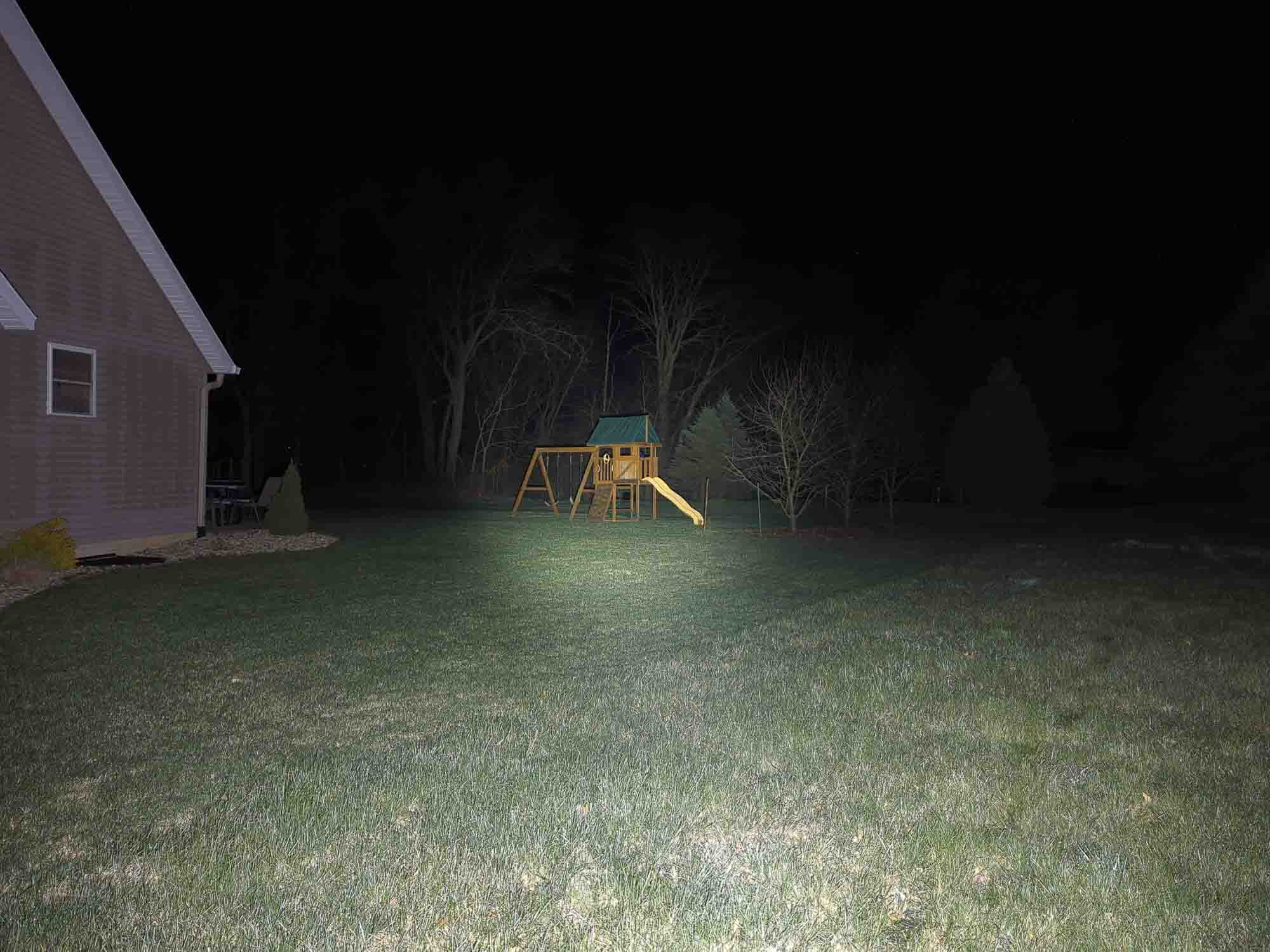
Disclaimer: This flashlight was sent to me for review at no cost by Banggood. I have not been paid to review, nor have I been holding back on problems or defects.
Final Verdict
Pros
- Brighter than spec
- Mostly good fit and finish
- USB-C charging
Cons
- Gets crazy hot
- Charging issues
- Bad UI
- Large jump from Low to Mid
Explanation on star ratings:
1: Avoid: my phone flashlight would be a better choice – 2: Poor: significant defect or issues; almost unusable – 3: Average: some defects or issues; but still usable 4: Good: recommended (minor issues) – 5: Great: highly recommended

2.5 stars: ★★⋆
I came into the Astrolux ST01 knowing that I wouldn’t be a big fan of the UI. That can be personal preference, but I don’t like hold-for-off. And I’m really used to double-click taking you to Turbo, which it does… if the light is already on. From off, a double-click takes you to strobe. That inconsistency is annoying and I found myself accidentally going into strobe way too much.
Also firmware related, the advertised “active temperature control function” doesn’t do enough to keep the operating temperatures in a safe range. You can very easily burn your hand with this light. Oh, and the Low mode is five times as bright as spec’ed, and even with that, the jump from Low (96 lm) to Mid (957 lm) is too big.
I’ve grown to appreciate lights that have built-in charging. It means that I can travel without needing to take a separate charger, or that I can give the light to a friend and they don’t need to worry about removing batteries, having a charger, etc. But no matter what I did, I couldn’t get the charging to work properly on my sample. Hopefully, that’s just a one-off issue, and that’s what warranties are for.
When it comes down to it, I have to remind myself that a few of the things that I really don’t like are personal preference (UI and mode spacing) and that as of the time of this review, you can get the Astrolux ST01 for less than $30. For that money, you’re getting a light with a decent fit and finish that can do 4000 lumens. That’s not too bad of a value, but depending on your needs you might be able to find a nicer light for a similar price.
Astrolux FT01 For Sale
1lumen selects and reviews products personally. We may earn affiliate commissions through our links, which help support our testing.